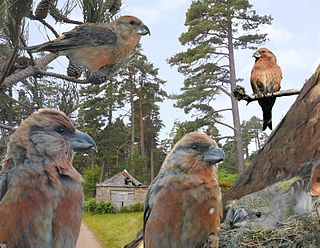
The Scottish crossbill is a small passerine bird in the finch family Fringillidae. It is endemic to the Caledonian Forests of Scotland, and is the only terrestrial vertebrate species endemic to the United Kingdom. The Scottish crossbill was confirmed as a unique species in August 2006, on the basis of having a distinctive bird song.

Trees for Life is a registered charity working to rewild the Scottish Highlands.
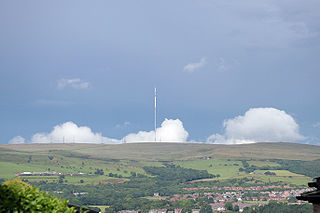
Winter Hill is a hill on which the three boroughs of Chorley, Blackburn with Darwen and Bolton meet in North West England. It is located on Rivington Moor, Chorley and is 1,496 feet (456 m) high. Part of the West Pennine Moors, it is a popular walking area, and has been the site of mining activity, aeroplane disasters and a murder.

Saddleworth Moor is a moorland in North West England. Reaching more than 1,312 feet (400 m) above sea level, it is in the Dark Peak area of the Peak District National Park. It is crossed by the A635 road and the Pennine Way passes to its eastern side.

Canford Heath is a suburb, an area of heathland, and an electoral ward in Poole, Dorset. It is known for being the largest heathland in Dorset, and the largest lowland heath in the UK. It is also the name of the housing development built on the heathland in the 1960s, 1970s and 1980s. At the 2021 census the population of the ward was 14,387.

Cannich is a village at the southern end of Strathglass, in the Highlands of Scotland, about 26 miles (42 km) west of the city of Inverness. It is at the furthest point of the A831 that loops around the Aird from Beauly to Drumnadrochit.
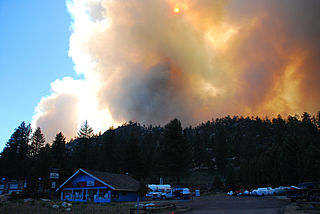
The Angora Fire was a 2007 wind-driven wildfire in El Dorado County, California. It started near North Upper Truckee Road subdivision near Angora Lakes, Fallen Leaf Lake, Echo Lake and South Lake Tahoe, California around 2:15 p.m. on Sunday, June 24, 2007, as a result of an illegal campfire. As of July 2, 2007, the fire was 100 percent contained, and 100 percent control was achieved on July 10. The fire burned 3,100 acres (12.5 km2), destroyed 242 residences and 67 commercial structures, and damaged 35 other homes. At the peak of the fire, there were as many as 2,180 firefighters involved in battling the blaze. The fire cost $13.5 million to fight and caused at least $150 million in property damage.
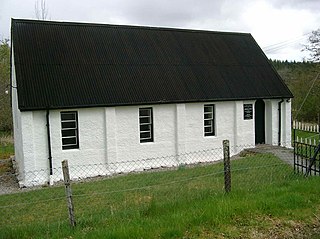
Corrimony is a small village at the western end of Glenurquhart, in Inverness-shire, in the Highlands of Scotland, now within Highland council area. It is 13 km west of Drumnadrochit, and 32 km south-west of Inverness.

Suffolk Fire and Rescue Service (SFRS) is the statutory fire and rescue service covering the county of Suffolk in East Anglia, England. It was formed in 1948 as the Suffolk & Ipswich Fire Service, before changing after the 1974 Local Government Review to 'Suffolk Fire Service'. Following the 2004 Fire & Rescue Services Act, the service name was changed to Suffolk Fire & Rescue Service to better reflect its role. Suffolk has a population of 760,556 and covers 1,466 square miles (3,800 km2). The county town is Ipswich with other major towns including Lowestoft, Bury St-Edmunds, Felixstowe and Newmarket.

Glen Cannich is a long glen and strath in the Northwest Highlands of Scotland and through which runs the River Cannich. Once densely populated before being largely emptied by both voluntary emigration and the Highland Clearances following the Battle of Culloden in 1746, the Glen, which was formerly the property of Clan Chisholm, has played an important role in the history of Scottish Gaelic literature, Scottish traditional music, and in the history, martyrology, and hymnography of the Catholic Church in Scotland. A minor public road runs up Glen Cannich from Cannich as far as the Mullardoch dam. Other than water capture for the Affric-Beauly hydro-electric power scheme, the major land uses in the glen are commercial forestry and deer stalking.

The Scottish Fire and Rescue Service (SFRS) is the national fire and rescue service of Scotland. It was formed by the merger of eight regional fire services in the country on 1 April 2013. It thus became the largest fire brigade in the United Kingdom, surpassing the London Fire Brigade.
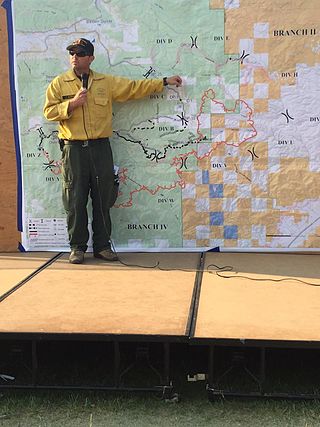
The Lake Fire was a wildfire that burned in the San Bernardino National Forest. The fire started on June 17, 2015, and burned over 31,359 acres before it was fully contained on July 21, 2015.

The La Tuna Fire was a wildfire in the Verdugo Mountains in Los Angeles County, Southern California, in September 2017. The fire began from undetermined causes on the afternoon of September 1 in La Tuna Canyon, and burned 7,194 acres (2,911 ha) before its containment on September 9. The fire caused at least ten injuries, the destruction of five homes and five outbuildings, and the evacuations of hundreds more. It was one of the largest wildfires in the history of the city of Los Angeles.
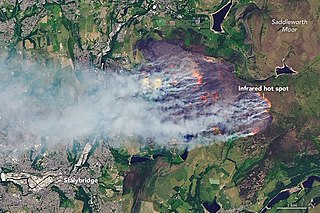
Starting on 24 June 2018 and continuing throughout the summer, a record-breaking series of wildfires burned across the United Kingdom. The two largest fires, which were declared major incidents, burned over 7 square miles each and broke out on Saddleworth Moor in Greater Manchester and Winter Hill in Lancashire. Other large fires broke out in Glenshane Pass in County Londonderry, Northern Ireland, Epping Forest, in London and in the Vale of Rheidol in Ceredigion, Wales. The Saddleworth Moor fire has been described as the largest English wildfire in living memory. Most of the wildfires occurred during the first official heatwave in the United Kingdom since June 2017, with temperatures reaching above 30 °C (86 °F) for several days, making the hottest June in the country since 1995, and the driest June for over ten years in large parts of the United Kingdom, exacerbating the crisis. A wildfire started on the Staffordshire Moorlands on 9 August and, despite rain, had spread to cover 219 acres by 11 August. Some hot spots were still burning as at 22 August. In total, there were 79 fires over the course of the year, a new record. However, the record was beaten in 2019 with 96 fires as of April 23.
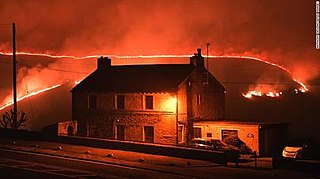
2019 United Kingdom wildfires were a series of wildfires that began on 26 February 2019 and ended on 18 May 2019. The series of wildfires was considered unusual due to the fact that they took place early in the year. Areas affected by the wildfires in 2019 included those that had already been burnt by wildfires during the summer of 2018. The fires have created many air pollution problems for the UK. The causes of most of the fires have been attributed to much higher than average temperatures and drought conditions that have prevailed since the spring of 2018. There were 137 wildfires larger than 25 hectares (250,000 m2) recorded in the United Kingdom in 2019. This beats the previous record of 79 from 2018.
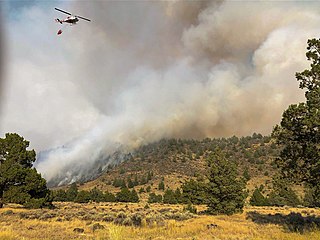
The Tucker Fire was a wildfire that burned near Clear Lake National Wildlife Refuge in Modoc County, California in the United States. The fire ignited on Sunday, July 28, 2019 along Highway 139 and went on to burn an estimated 14,217 acres of land. As of August 15, the fire was 95% contained. Officials say the wildfire was caused by traffic on Highway 139.

The 2021 Table Mountain fire is a major fire that started on 18 April 2021 in and around Table Mountain National Park and the neighbourhoods of Newlands, Rosebank, Mowbray and Rondebosch in Cape Town, South Africa. The damage to sites in the Table Mountain area included the Rhodes Memorial, where a restaurant burned down; the upper campus of the University of Cape Town (UCT), where the Special Collections library was gutted; and Mostert's Mill, a historic windmill that burned down. In addition, five firefighters were hospitalised.

The 2020 Wareham Forest fire was a wildfire in Wareham Forest, Dorset, in May 2020. It destroyed over 220 Hectares of the heathland, and was described "one of the most devastating fires in Dorset, in living memory" by Dorset and Wiltshire Fire and Rescue Service.

In June through August 2022, parts of Europe, the Middle East and North Africa were affected by wildfires. The bulk of the fires affected Mediterranean countries, with the main areas affected being Algeria, France, Greece, Portugal and Spain.

The 2022 United Kingdom heatwaves were part of several heatwaves across Europe and North Africa. The United Kingdom experienced three heatwaves; the first was for three days in June, the second for three days in July, and the third for six days in August. Climatologists say the extreme heat was due to climate change. 2022 was the UK's warmest year since records began in 1884, with an average annual temperature above 10 °C (50 °F) for the first time. The 2022 heatwaves contributed to the death of nearly 3000 people, most of whom were 65 years or older.






















